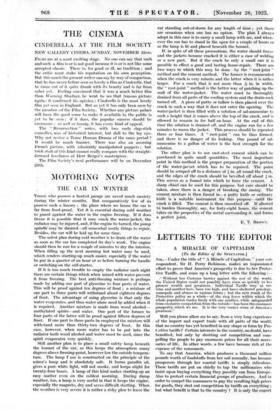OTORI-NG - NOTES
THE CAR IN WINTER
TIIOSE- who-possess a heated- garage are saved much anxiety during' the 'Winter; Months. " • But •ccinipitratively fevi of us possess"-such a luxury ; the 'place "where we honk the ear is far from frost-proof. Yet it is essential (hiring cold weather
to guard against the water in engine freezing. If it does freeze it is possible that it may crack the water-jack-et,- the radiator may be injured, and, if the engine be turned,thepiimp sphidle May-he sheared-all= somewhat costly things torePair. Besides, the car will be laid up_ for- some time. The safest plan during cold weather is to arain off -the water as soon as the car has completed its day's -work. The engine should 4hen be run for a' couple of minutes to dry the interior. When filling up the next morning -hot water may be used, which renders starting-up much easier, especially if the water be put in a quarter of an hour or so before turning the handle or switching-on the self-starter. - . _ . . _ _
If it is too much trouble to empty the -radiator each night there are certain things which when mixed with water prevent it from freezing. The best anti-freezing "mixture is perhaps made by adding one part of glycerine to four parts of water. This will be proof against ten degrees of frost ; a mixture of one part to three parts will withstand about eighteen degrees of frost. The advantage of using glycerine is that only the water evaporates, and thus water alone need be added when it is required. Another mixture is made from wood alcohol— methylated spirits—and water. One part of the former to four parts of the latter will be proof against fifteen degrees of frost. If one part to three parts be employed the mixture will withstand more • than thirty-two degrees of frost. In- this case, however, when more water has to be Put into -the radiator both wood alcohol and water must be used, since the spirit evaporates very quickly.
Still another plan is to place. a small safety lamp beneath the bennet of the car, as this keeps the atmosphere many degrees above freezing-point, however low the outside tempera- ture. The lamp I use is constructed on the principle of the miner's lamp and is absolutely safe. It burns paraffin oil, gives a pure white light, will not smoke, and keeps alight for twenty-four hours. A lamp of this kind makes starting-up an easy matter even on the coldest morning. During damp weather, too, a lamp is very useful in that it keeps the engine, eipecially the magneto, dry and saves difficiilt starting. When the weather is very :severe it is rather a risky plan to leave the
• • •
car .standing out-of-doors for any length of time ; yet there are occasions when one , has• no option. The plan I always adopt in this case is to carry a small laMp with rne,nnd when- ever the car his to stand in the open' for a couple of hours or so the lamp is lit and placed beneath the bonnet.
If, in spite of all these precautions, the water. should freeze and the jackets become cracked it is either a case of welding or a new part. But if the crack be only a small one it is possible to effect a -good and lasting home-repair. There are two ways in which this may be done—by the. " rust-joint" method and the cement method. The forMer is recommended When the crack is very minute and the latter when it is' rather larger. For a crack that. is not. more than s hi. in width, the " rust-joint" method is the-better way of patching Up the wall of the water-jacket. The water must be thoroughly drained from all parts of the cooling system and the drain-cock turned off. A-piece of-putty or tallow is-then placed over the crack in such a way that it does. not enter the opening. The water-jacket is then filled with a solution of sal-ammoniac to such a height that it comes above the top of the crack, and is allowed to -remain in for half an hour. . At the end. of- this time the Solution is drained off, and the engine run fOr a few minutes to warm-the jacket. This process should be repeated three • or four times. A " rust-joint " can be thus forined and there is no danger of - its leaking. One pound of sal- ammoniac to a gallon of water is the best-strength for' the
solution. • - - -
The_ other plan is .to use cast-steel cement which can be purchased . in quite - small quantities. The - most. important point in this method is the.proper preparation of the portion of the Water-jacket whieh has to be. repaired. . The- paint should be scraped off to a diStorice of I in all round. the crack, and the • edgei- of the erackShOuld be bevdled off Wart Tip: This • serves as a fiinnel into .which to force the ceMent.--.A shrirP chisel canused for this care 'should. be • taken, since _there is. a, danger. of breaking the easing:. -The
cement lirniXture is then forced knife or ordinary
knife is a instrument: for this iirpriseuntil the cii.ick is filled. The cernentikthensthoothed Off. If allowed to harden thoroughly, saY, for forty-eight hours, the cement takes on the properties Of the metal surrounding it acid fOrths
a perfect joint. . _ .
T. 13110W.S..






















































 Previous page
Previous page